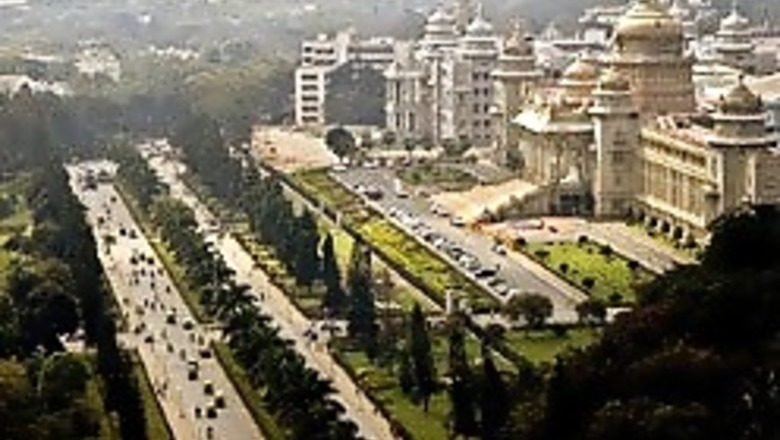
views
If electoral politics in the country has moved from the national to the state in the last decade, within Karnataka this period has witnessed a rise of different political regions as distinct political entities. Each of the regions of Karnataka has its own historical significance, political dynamics, caste equations and local socio-cultural specificities. The findings of the Deccan Herald-CNN-IBN--CSDS confirm the crucial role of the various regions within the state.
Southern Karnataka is the ‘heart’ of the Old Mysore region. This was part of the princely state of Mysore in the pre-Independence days. It accounts for nearly one fourth of the seats in the state (51 seats).

Southern Karnataka is also a region where one of the dominant castes in the state—the Vokkaliga community—has a significant political presence. The region has historically seen a stiff competition between the Congress and the Janata Party/Dal. The BJP did attempt to carve out a base and has achieved some success.
As the campaign picks up, the pre-poll indicates that the fight in most constituencies is between the Congress and the Janata Dal (S). The BJP appears to be very much the third force at the ‘margins’ in this region. The JD (S) enjoys the support of a majority of Vokkaligas, but not the kind of en-bloc support that it may have hoped for to neutralize the support to the Congress among the dalits and Muslims in this region. If the JD(S) is the party of the socially dominant and the well off, all the marginalized and poor have aligned with the Congress.
The Bangalore region has always been ‘politically important’. The recent delimitation exercise has underscored the presence of this region. It accounts for 36 seats, around one-sixth of those in the state. The urban areas in the Bangalore region had seen BJP victories. When the Janata Party came to power in the state in the 1980s, it put up a creditable performance in the city. Off late, the Congress has been capturing a majority of the seats in the metropolis. In the rural segments of the Bangalore region it has mostly been a contest between the Congress and the Janata Dal (S).

PAGE_BREAK
While the urban pockets have a mixed caste cluster, many of the rural areas have a strong presence of the Vokkaligas community. The pre-poll shows that the Congress share of votes in this region is impressive. The BJP is quite a distant second with the Janata Dal(S) being in a close third position. If the numerically large upper caste support the BJP, the Vokkaligas in the rural areas are split between the Congress and the LD(S) while the bottom of the social pyramid is strongly with the Congress. This region witnesses a sharp class division with the poor backing the Congress.
The Hyderabad-Karnataka region accounts for 31 of the seats in the state and was part of the Nizam`s territory before independence. It contains some of the most economically backward regions of the state. It has traditionally been a stronghold of the Congress. The BJP has not been able to register a significant presence across the region. The JD(S) did register a few wins in the region in 2004.

The pre-poll shows that the JD(S) has registered a decline, thus allowing the Congress to take a big lead in this region. Two if its prominent leaders, Mallikarjun Kharge and Dharam Singh, are contesting from here. The Congress appears to have split the Vokalliga as well as the Lingayat votes in this region besides building a huge lead among the backward castes, Muslims and dalits. The Congress can expect its best performance in the region.
The Mumbai-Karnataka region covers the areas which were earlier part of the Bombay presidency and accounts for a little less than one fourth of the seats in the state (50 seats). This region has traditionally witnessed the domination of the Lingayat community.

The BJP did very well in this area in 2004. The pre-poll indicates that this is the only region where the BJP continues to dominate. Besides a solid support from the upper castes and the Lingayat community, the BJP also has considerable influence among the other landowning castes and the backward castes, enough to overcome the Congress’ support among the Muslims and dalits. The race appears principally between the two national parties with the Janata Dal(S) at a distant third position.
The coastal region, with only 21 seats but a very distinct social and political flavour, has served as a foundation stone for the rise of the BJP in the state. The BJP’s good show continued in the assembly elections of 2004. Early indications are that his time around, the Congress seems to have gained a slight edge with the BJP in a competitive second place. The caste pattern in this region is very different from the rest of the state. The upper caste and Vokaliggas are split between the Congress and the BJP. The BJP gets its support from the backward castes while the Congress matches it with support from among dalits and Muslims.
The Central Karnataka region is made up of what was traditionally the Northern end of the Old Mysore princely state. All three major parties have pockets of influence in this region.

The pre-poll indicates a close three pronged race. Of the all the regions, Central Karnataka appears to indicate no clear trend in favour of any one of the three parties. If the BJP takes a lead among upper half of the social pyramid, including among the Vokaliggas and the Lingayats, the Congress enjoys the backing of the Backward castes, dalits and Muslims. The JD(S) is down, but not out of the race.

Methodology used for Karnataka pre–poll survey
















Comments
0 comment